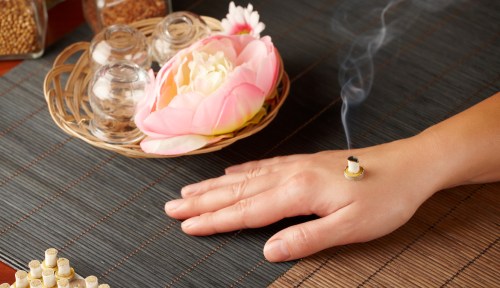You’re far from alone if your go-to solve for everyday aches and pains is popping an anti-inflammatory aspirin or ibuprofen. While this can certainly be an effective tack, if you’re looking for another tool to add to your pain-relieving toolbox, Traditional Chinese Medicine (TCM) may have a few—namely, acupuncture and moxa (a mugwort-herb therapy), both of which are rooted in restoring overall balance and flow. When they’re combined in a therapeutic treatment typically called moxibustion, the results can deliver soothing, pain-alleviating benefits.
Experts in This Article
board-certified acupuncturist, herbalist
Sian James, LAc, DACM, is the lead acupuncturist at New York City acupuncture studio Ora. She is licensed in Acupuncture and Massage Therapy in the states of Connecticut, New York, and Pennsylvania. She completed her graduate and doctorate studies at Pacific College of Oriental Medicine, and her Masters of Science in Chinese Herbology at the University of Bridgeport’s Acupuncture Institute. Dr. James pledges herself towards the lifelong commitment of mastering alternative medicine and offering this powerful art and science of holistic healing. She is board certified by the NCCAOM®, NCBTMB®, and by the National Acupuncture Detoxification Association as an Acu Detox Specialist.
To understand how moxibustion works, it’s helpful to first picture the body’s meridians, or the energetic pathways that form the bedrock of TCM. These channels—which connect the various organs to points in the arms and legs—were established thousands of years ago, prior to 168 BC, according to an ancient Chinese medical text. And encouraging the free and open flow of qi (aka energy) along them was thought to promote healing and resolve disease and disorder.
Also in that text, The Ancient Medical Relics of Matvangdui, is what’s considered to be the first mention of a moxa or moxibustion treatment, during which a practitioner burns a version of the dried mugwort herb on or near certain meridian points along the body to encourage that flow of qi (more on this below). And it was only several years later, during the Western Han Dynasty, that acupuncture appeared for the first time in a medical text as a way to manipulate those same points with tiny needles. Today, moxibustion practices typically combine elements of these two therapies for a best-of-both-worlds TCM approach.
Reasons to consider a moxibustion treatment
Different from modern Western-medicine treatments, which are typically formulated as one-to-one solutions for ailments, TCM therapeutic techniques, including moxibustion, work on whole body systems. As a result, they can play a role in helping a variety of concerns, offering wide-ranging benefits that mostly depend on the person receiving them.
Because acupuncture is a key component to a moxibustion treatment today, it’s worth noting that folks might turn to moxibustion for any of the proven upsides of acupuncture, including its potential to minimize chronic pain (based on a 2017 analysis of 39 trials on nonspecific musculoskeletal pain, osteoarthritis, chronic headache, and shoulder pain), as well as reduce pain linked to menstrual periods, and improve sleep quality.
“The acupuncture and moxa, together, further promote the physiological response of increased circulation.” —acupuncturist Sian James, LAc, DACM
But the unique practice of moxibustion may level up some of those benefits you’d be able to get from acupuncture alone. “Combining moxa with acupuncture works synergistically,” says Sian James, DACM, LAc, lead acupuncturist at Ora, a New York-based acupuncture studio. “The acupuncture and moxa together [can] further promote the physiological response of increased circulation.” And, in turn, that improved blood flow can both decrease inflammation and boost your range of motion and flexibility, which can help with chronic muscle and joint pain, adds Dr. James.
Research backs her up: A 2017 review of studies analyzing the efficacy of moxibustion for osteoarthritis in the knees suggests it can help with both pain reduction and symptom management, while a separate 2020 review found that moxibustion may help relieve the nerve-root compression and swelling commonly linked to chronic low-back pain.
Similarly, the circulation-boosting effect of moxibustion can offer some pain-relief benefits to period-havers. “Moxa works to drive blood flow to the uterus, which can help calm severe menstrual cramps,” says acupuncturist and herbalist Giselle Wasfie, DACM, LAc, founder of Remix Lifestyle, a Chicago-based acupuncture studio. And a small 2015 study of moxibustion’s efficacy for treating cramps in 56 nursing students demonstrated this pain-reducing effect, too. “Burning moxa also has an exterior benefit through its scent, which is slightly sweet and herbal, and can be very soothing to the spirit, naturally opening the heart,” adds Dr. Wasfie.
Within the gynecological realm, moxibustion is also frequently used as part of a treatment for infertility, as this is often linked in TCM to coldness in the uterus, where moxa can supply necessary warmth, says Dr. Wasfie. In fact, a small 2018 study of 40 people attempting to get pregnant found that moxibustion may actually increase endometrial thickness, and, in turn, help with effective embryo implantation. But even so, it’s worth consulting your OB/GYN before getting a moxibustion treatment for fertility reasons, particularly if there’s any chance you could be pregnant.
What to expect from a moxibustion treatment
First things first, don’t worry about your skin getting burned by the smoking moxa. Though there are traditional methods of direct moxibustion that involve the burning mugwort herb actually touching the skin, the most common practices of moxibustion done today are indirect ones, which began to develop in China as early as the 10th century. These indirect practices simply involve a buffer of some sort between the skin and the burning herb, and can take a variety of different forms.
Commonly, a practitioner will wrap the dried mugwort herb into a roll that looks a lot like a cigar, light it, and hold it just above a particular acupuncture point, says Dr. James. “Alternatively, moxa can also be rolled into rice-sized or slightly larger cotton-ball-sized shapes and placed on top of acupuncture needles after they have been inserted,” says Dr. James. “The needles are then heated, allowing the moxa to burn down, and penetrate into the channel.”
Another approach? Start with acupuncture, and then follow with moxa. After needling a patient, Dr. Wasfie often applies smaller sticks of moxa on top of anti-burn jelly (for extra protection). To cover larger areas, she’ll use a moxa box, which involves heating the loose moxa inside a small box placed on the skin so that the warmth is felt but still indirect, in order to prevent burning.
As for where exactly the moxa is applied on the body, that’s determined by a comprehensive intake discussion with your TCM practitioner, similar to the chat you’d have before an acupuncture treatment. They’ll get the low-down on your symptoms, assess which meridian points could be most effective to target, and ensure you don’t have any preexisting conditions for which moxibustion might be contraindicated, like, for example, a respiratory condition that could be aggravated by the smoke or an open wound that shouldn’t be exposed to the burning moxa, says Dr. James. (At this stage, it’s a smart idea to disclose any medical conditions and medications you take in order to ensure a fully safe treatment.)
How to find a practitioner whom you can trust for moxibustion
As is the case for scouting any health-care professional, finding a TCM practitioner who’s licensed, experienced, and practicing all regular hygiene measures (like sterilizing needles and washing their hands between patients) is essential to receiving a helpful and safe moxibustion treatment.
Look for the credentials “LAc” behind your practitioner’s name to ensure they’re actually licensed to do acupuncture, and thus have at least three years of graduate-school training under their belt. It’s also wise to scroll through their site and check that they’re board certified by the National Certification Commission for Acupuncture and Oriental Medicine. Once you find a practitioner whom you’re interested in seeing, schedule a consultation with them before making a treatment appointment to be sure they’re comfortable with moxa and familiar with doing moxibustion for whatever pain, stiffness, or soreness you might be feeling.
Oh hi! You look like someone who loves free workouts, discounts for cutting-edge wellness brands, and exclusive Well+Good content. Sign up for Well+, our online community of wellness insiders, and unlock your rewards instantly.
Sign Up for Our Daily Newsletter
Get all the latest in wellness, trends, food, fitness, beauty, and more delivered right to your inbox.
Got it, you've been added to our email list.









